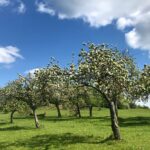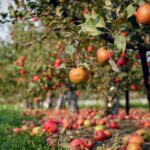Choosing the best mulch for flower beds is essential for both the health and appearance of your garden. Mulch not only adds a polished, finished look to your flower beds, but it also provides vital benefits for plant growth. The right mulch helps retain moisture, which is crucial during hot summer months, and it regulates soil temperature—keeping the ground warmer in early spring and protecting roots during winter freezes. This is especially beneficial for shallow-rooted shrubs like hydrangeas and for newly planted perennials that are more vulnerable to temperature fluctuations.
Also, read my guides on:
Yellow Hydrangea Leaves? Find Out Why & Fix It Fast
Discover the Best Compost for Your Vegetable Gardens
There are various mulch types, with shredded hardwood and pine straw being popular choices for flower beds. These organic mulches break down naturally, adding valuable nutrients to the soil over time and improving its texture. A 2 to 3-inch thick layer of mulch provides effective weed prevention, reducing the need for constant weeding and blocking weed seeds from sprouting. It’s also useful for creating a volcano shape around the plant stem or trunk, helping to prevent pests and diseases by keeping the plant stems off wet mulch.
One key to successful mulching is using the right amount—a few inches of mulch can protect your plants from the elements and improve moisture retention. Mulching helps to reduce the freeze-thaw cycle by insulating the soil, which prevents frost heave. Organic mulch contributes to healthier soil as it gradually breaks down, providing ongoing nutrients and enhancing the overall health of your garden. Be sure to adjust your mulch layers based on the regional availability and space in your garden to make sure your flower beds stay protected and flourishing year-round.
Mulch Benefits
Using mulch in your garden offers a variety of benefits that help plants thrive.
A thick layer of mulch, such as organic materials like compost, can protect plants from the harsh summer sun.
It helps retain moisture, preventing the soil from drying out and keeping it from becoming too hard.
Mulch also shields the soil from direct sunlight, reducing the amount of water lost to evaporation. This is especially important during hot weather when the plants need more water to stay healthy.
In addition to moisture retention, mulch also plays a key role in weed prevention. A good layer of mulch blocks light, making it difficult for weed seeds to sprout and grow. By reducing weed growth, mulch makes it easier for your plants to get the nutrients and space they need without competition.
Moreover, as organic mulch, like compost, breaks down, it adds nutrients to the soil, improving its structure and fertility, which promotes healthy plant growth.
Another benefit of mulch is its positive environmental impact. By using organic mulch, such as compost mulch, you help reduce carbon emissions and fight climate change.
The breakdown of organic materials in mulch provides fuel for soil organisms, enhancing soil health and supporting the growth of living things in the ground. This creates a healthier, more sustainable garden while helping to reduce the amount of greenhouse gases in the air.
Select the Right Mulch for Your Garden
When choosing the best mulch for your flower garden, it’s important to consider both practical and aesthetic roles. Mulch plays a key part in protecting the soil, as it helps to reduce moisture loss, regulate soil temperature, and prevent weed growth. For flower beds, a layer of mulch around your plants provides insulation, keeping the root zone warmer during winter and cooler during extreme cold in the summer. This is especially important for perennials that need extra protection to survive fluctuating temperatures.
In addition to protecting your plants, mulch also improves the aesthetic of your garden. Using materials like clipped lawns or other organic mulch types can help create a neat and pulled-together look for your flower beds. Whether you prefer a more natural or polished appearance, the right mulch adds a finishing touch that complements your plants. It also helps minimize the spread of weed growth, keeping your garden looking tidy and preventing competition for nutrients.
The right mulch not only supports plant health but also enhances the overall look of your garden. By choosing the right material, you can reduce the need for constant weeding, improve temperature moderation, and protect your plants from the elements. Whether you opt for an insulating mulch or something with a decorative appeal, mulch provides a strong foundation for your flower plants to thrive year-round.
Choose an Effective Yet Attractive Mulch
When choosing mulch for your flower gardens, it’s important to consider both its effectiveness and appearance. The best mulch should not only help with moisture retention and weed control but also complement the beauty of your plants. For a more natural look, opt for finely textured mulches like shredded bark, which blend well with a variety of flower shapes and sizes. If you’re looking for something that contrasts nicely with your flowers, a neutral colour mulch can help your plants stand out without overwhelming the overall aesthetic of your garden.
A different approach might be to use materials like carpet remnants or black plastic, which are more commonly used in vegetable gardens but can be effective in flower beds when placed strategically. These options can also help reduce the competing growth of weeds while offering a neat and uniform look. The key is to select a mulch that not only meets the needs of your flowers but also enhances their visual appeal. Easily spread materials ensure that the job is simple and the results are long-lasting, leaving your flower garden looking well-kept and flourishing.
The Best Mulch for Flower Beds
Organic Mulch
Shredded Hardwood Bark
Shredded hardwood bark is a common and economical choice for flower beds. It’s one of the most affordable types of mulch and is available in many varieties. This mulch breaks down slowly, providing a long-lasting solution that improves soil texture and moisture retention. It’s also environmentally friendly, making it a great option for those looking to reduce their environmental footprint. It works especially well for trees, shrubs, and perennials and is ideal for flower beds that need steady support for plant health.
Straw
Straw is an inexpensive option, commonly used in vegetable gardens but also perfect for flower gardens. It offers excellent moisture retention, keeping the soil cool during the summer and reducing the chances of weed seeds sprouting. Straw works well when applied in thick layers and can be easily spread around plants like newly planted perennials or shallow-rooted shrubs. However, it does break down quickly, so it may need to be replenished more often, especially in highly exposed beds.
Pine Bark
Pine bark comes in large chunks or nuggets, offering a more rustic touch to your flower beds. It is dark-coloured and helps with weed suppression by blocking light to weed seeds. The rough texture of pine bark makes it perfect for preventing the soil from drying out in hot weather while maintaining aesthetic appeal. This type of mulch is especially beneficial for areas with shallow-rooted plants, as it provides both insulation and protection for the root zone. You may need to reapply it from time to time, but it remains effective for long periods.
Compost
Compost is a great option for those looking for a budget-friendly mulch that also improves soil fertility. Made from grass clippings, leaves, and other organic matter, it works to add essential nutrients and improve soil texture. Compost helps with moisture retention and enriches the soil over time, making it an excellent choice for flower beds. It’s often free or very low-cost, especially when created at home, making it a cost-effective option. This organic mulch works well in most flower beds and is ideal for anyone aiming for a sustainable garden.
Cocoa Bean Hulls
Cocoa bean hulls are a handsome, dark brown mulch that adds a chocolaty scent to your garden. This fine-textured mulch is often used for decorative purposes and moisture retention. However, it is important to note that cocoa bean hulls are toxic to pets, especially dogs and cats. If you don’t have pets, these hulls are a great way to give your flower beds a polished, rich look. They compact easily, which helps maintain consistent moisture in the soil and allows for good water flow to the roots of your plants.
Inorganic Mulch
Stones and River Rock
When choosing mulch for rock gardens or areas with cacti, stones and river rock are ideal. These inorganic materials don’t break down over time, providing a long-lasting, low-maintenance option. However, they can get hot in the sun, which may not be suitable for all plants. They also need landscaping fabric underneath to prevent weeds, and it often has to be reapplied yearly. While expensive, they improve the soil and offer a sleek, polished look for your garden.
Pea Gravel
Pea gravel, made up of small stones that resemble large peas, is a practical and attractive option for paths and garden beds. With its sandy colour, it adds a soft touch to the landscape. It’s weed-free, and when applied an inch deep, it can help maintain a weed-free environment. Pea gravel is also easy to contain and is great for landscaping beds, edging, and walkways. Though it doesn’t provide organic matter or nutrients, it improves soil structure and offers a neat, tidy appearance.
Some Mulches to Avoid
Pine Needles
While pine needles or pine straw might seem attractive, they are acidic, which is fine for acid-loving plants like azaleas and rhododendrons. However, this acidity can affect other plants in your garden, lowering the soil’s pH over time.
Grass Clippings
Grass clippings may seem like a convenient mulch, but they can be tricky to use. If not properly dried, they fuse into a mat, inhibiting both water movement and air movement, which are essential for healthy soil and plants.
Well-rotted Straw
Though well-rotted straw can be good for mulch, it tends to become clumpy and difficult to spread, making it a less effective option for flower beds.
Polyester Weed Fabric and Black Plastic
Polyester weed fabric and black plastic should generally be avoided in flower beds or landscaped areas with shallow-rooted perennials. They can block water movement, prevent roots from growing freely, and lead to poor soil health.
Shredded Rubber Mulch, Lava Rocks, and Stone
Shredded rubber mulch, lava rocks, and stone do not break down or mix into the soil effectively. These materials can hinder your garden’s ability to improve its soil structure and nutrient content.
How to Apply Mulch to Flower Beds
Timing and Frequency
When applying mulch to your flower gardens, timing and frequency are key. It’s best to apply mulch in late spring or early summer once the soil has warmed up. This ensures that the mulch will help retain moisture and protect the soil from summer heat. Applying mulch annually in early spring and adding a fresh layer each season can significantly benefit your plants. If necessary, you can also touch up areas where the mulch has thinned out.
Prep the Area for Mulching
Before adding mulch, it’s important to prep the area for mulching. Clean the garden area by removing any weeds and raking the soil. If there is any existing mulch, make sure to fluff it up to prevent it from forming a hard mat that can block moisture. You can also use Preen or other pre-emergent products to stop germinating seeds from sprouting. Adding fertilizer or compost before mulching can help provide your plants with extra nutrients. Watering the soil will ensure it is moist before covering it with mulch.
Tips for Mulching Flower Gardens
1. Choose the Right Mulch: Select a mulch material that suits your flower garden needs. For example, shredded bark or cedar mulch works well for most plants. Avoid using compacted mulch around the base of perennials or low-growing plants like creeping phlox, as this can suffocate the roots.
2. Apply the Right Amount: Spread a layer of mulch about 2 to 3 inches thick over the soil surface. This helps retain moisture, suppress weed growth, and regulate soil temperature. Be careful not to over-mulch, especially around stems and crown areas of plants.
3. Keep Mulch Loose: Regularly fluff the mulch to prevent it from forming a mat. This will allow water to be absorbed by the soil and improve air circulation around plant roots.
4. Watch for Pests: Mulch can attract pests. Check for any creeping insects that may hide under the mulch. If needed, use cedar mulch, which naturally repels insects, around more vulnerable plants like peonies.
5. Add Living Mulch: Consider using living mulch, like liriope or candytuft, in areas where you want additional coverage. These plants provide foliage, enrich the soil, and reduce moisture loss while creating a beautiful garden appearance.
Also read my guide on:
Garden Soil or Potting Soil: Key Differences and Benefits
Final Observations
Choosing the right mulch for your flower beds is essential for plant health and garden aesthetics. Mulch not only enhances the beauty of your garden but also protects plant roots from temperature fluctuations and helps retain moisture. By selecting the best mulch, applying it correctly, and maintaining it through the season, you’ll ensure your flower beds thrive and remain vibrant year-round. Whether you go for organic or inorganic options, mulch is a simple yet effective way to create a flourishing and sustainable garden.
FAQs
Q- How much mulch do I need?
You need about 2 to 3 inches of mulch for effective coverage in flower beds. This helps retain moisture, prevent weed growth, and regulate soil temperature.
Q- What type of mulch is best for flower beds?
The best mulches for flower beds include shredded hardwood bark, pine straw, and compost. These organic mulches enrich the soil, retain moisture, and help with weed control.
Q- What is the best mulch for flower farming?
For flower farming, shredded hardwood mulch and pine bark are ideal. They provide nutrients, improve soil structure, and are durable for large areas.
Q- What is the best mulch for preventing weeds?
Shredded bark, pine straw, and compost are great for preventing weeds. These mulches block sunlight and reduce the growth of weed seeds in flower beds.
Q- Which mulch smells the best?
Cedar mulch has a pleasant, natural aroma. It also repels insects, making it a good choice for gardens and flower beds.












